6 Best Free Beat Making Software Apps in 2022
Beats are the heart of nearly all music but they’re the absolute core of electronically produced music. Being able to quickly draft, compose and edit beats is extremely important for musicians of all kinds.
So, whether you’re a learning producer wanting to draft your initial ideas or are a musician looking to create royalty-free backing tracks to play to, beat making software is an invaluable component of your music software arsenal.
Music production is not just a profession but a hobby for millions worldwide. Once upon a time, music production was reserved for those who could afford tons of expensive gear like synthesizers, hardware compressors, sequencers, etc. Now, the primary prerequisite is simply a competent computer or laptop.
What do you Need to Make Beats?
When we talk about beatmaking, we may be talking about producing drum beats which can be used for a variety of purposes:
- Recording yourself playing along to a drum beat with other instruments
- Making beats for import into other programs
- Making percussion loops for DJ sets
- Practicing your construction of rhythms and beats
We may also be talking about completing full tracks with both drumbeats, melodies and other FX.
Beats are intrinsic to most genres of music but are particularly important in genres such as hip-hop, electronic music (EDM, techno and drum & bass).
Whatever you want to make, we’ve compiled a list of the best free beat making software.
1. GarageBand
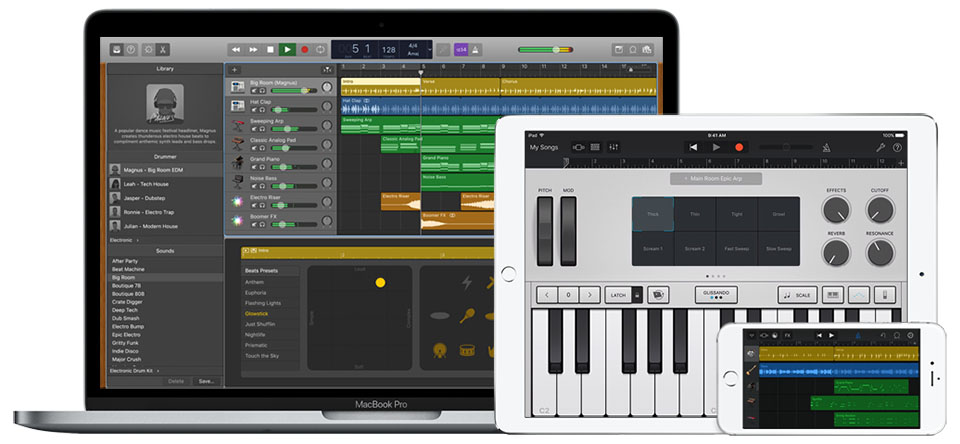
Compatibility: Mac only
GarageBand comes with Macs and it’s essentially a stripped down version of pro software Logic Pro X. With tons of easy-to-use features, GarageBand has defeated its free status by providing a near-professional suite of tools for all levels of music production.
Interface: When you initially open a project, you can pick which style of project you want to load. There is an option for hip-hop, electronic, multitrack (for recording) and blank project. This makes production easy right from the get-go – you simply choose the best option and let GarageBand gather the appropriate modules and effects.
For beat making, the hip-hop project mode is truly awesome and features Smart Drum Kits which are easily editable in both their samples, rhythms and FX. There’s tons of intuitive options and everything is laid out to make things as simple as possible.
With a sleek and professional interface, GarageBand is easy to navigate and it’s easily usable for those who have no experience in producing music on computers.
Content and Features: GarageBand doesn’t skimp out on advanced features. It has many good plugins and many are just stripped down versions of Logic favorites. It features time-stretching tools, full MIDI compatibility with hardware, advanced automation controls and many other things that are great to experiment with when you’re used to the software.
Bottom Line: GarageBand is mostly criticised for being too simple. Once you really get to grips with it, though, you realise that it offers much more than you might have expected. Don’t be put off by the simple and minimalist interface – GarageBand is a powerful piece of software for beat makers.
2. Tracktion 7
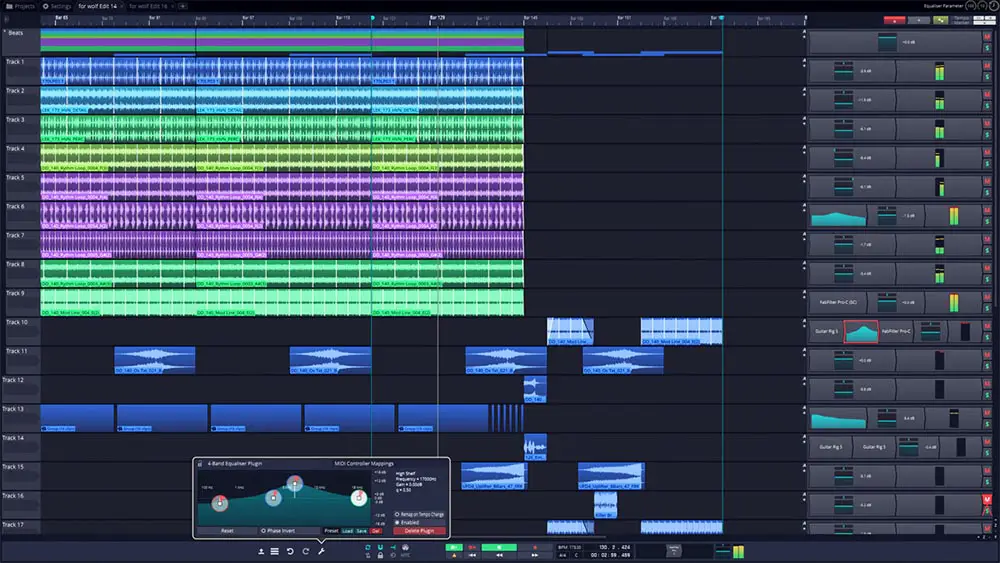
Compatibility: Mac, Windows and Linux
Tracktion 7 is a beat making DAW which features a fully featured free-forever version. You can buy extra plugins and tools but the core version is completely free. It’s a fairly old program but the recent version features a major overhaul which has modernized its interface and functionality massively.
Interface: Tracktion 7 looks miles away from Tracktion 6’s aged interface. Its steely blue look is professional and usable. It features a nifty selector which allows you to glide between the mixer, loop/waveform view and input/output selection, etc. Tracks are laid attractively and everything is easily accessible. You can automate with patterns, which is brilliant for beatmaking.
Content/Features: Tracktion 7 comes with a host of basic plugins including EQs, limiters, compressors and basic FX like reverb. It includes unlimited VST support so you can use absolutely any VST you can find online (and there are thousands of free VSTs). One excellent feature to Tracktion 7 is its Clip Layer mode which allows you to apply subtle effects to singular tracks without affecting the original waveform.
Bottom Line: Tracktion 7 is arguably the most feature-rich and dense of all free DAWs, but it isn’t the easiest to use. Full VST support is a big plus.
3. FL Studio
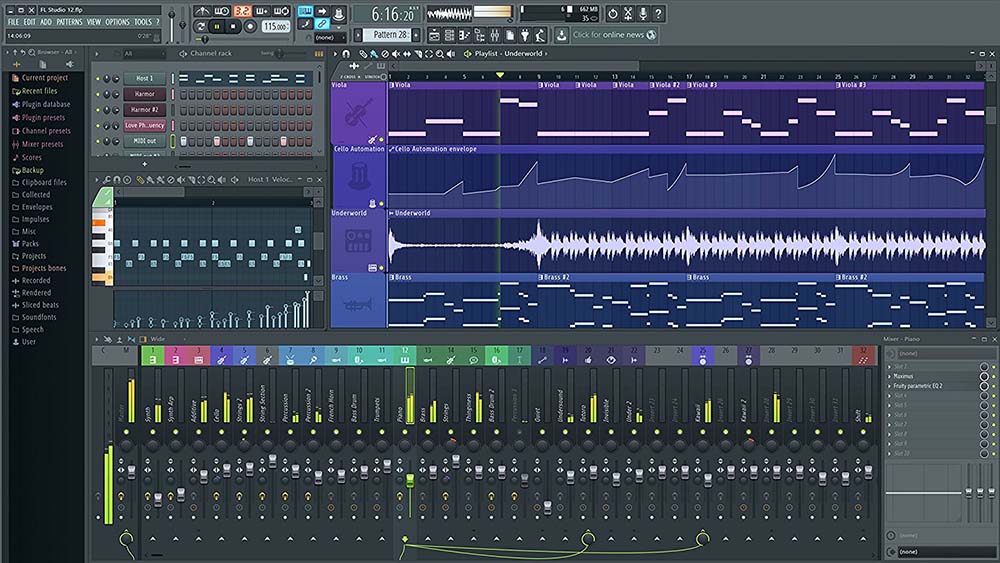
FL Studio is a pro-level DAW and it features everything you could need as a beatmaker. FL Studio’s free version allows you full access to its DAW and all plugins in its main bundle so you can try absolutely everything. Firstly, let’s mention what FL Studio doesn’t let you do: you can’t open saved projects. So, you can use the software continuously and then export to WAV or MP3 but you can’t reopen any projects you save.
Interface: FL Studio’s interface has always been one of its primary selling points. Its ultra clean and highly usable. Once you’re used to its smooth and rather minimalist design, you can easily shift between the mixer, track/waveform view and other features like automation.
FL Studio’s interface is awesome for making beats thanks to its world famous step sequencer. It’s very intuitive, you simply fill in the blocks to construct a fully editable and effectable beat.
Features/Content: FL Studio excels itself in every way other than in the mixing department where is a bit limited. It features many awesome plugins that are feature-rich and easy to apply and control.
For beatmakers, FL Studio includes everything in plugin form, so you won’t need hardware. In fact, it’s long been designed with ‘in the box’ production in mind. FL Studio comes with too many plugins to mention. It’s just its pesky limitation which prevent it from easily defeating this list of other free software!
Bottom Line: FL Studios ‘unlimited’ free trial is awesome but its limitations force you to work all in one session without saving. You can just leave your PC on – an archaic but workable solution!
4. Studio One 4 Prime
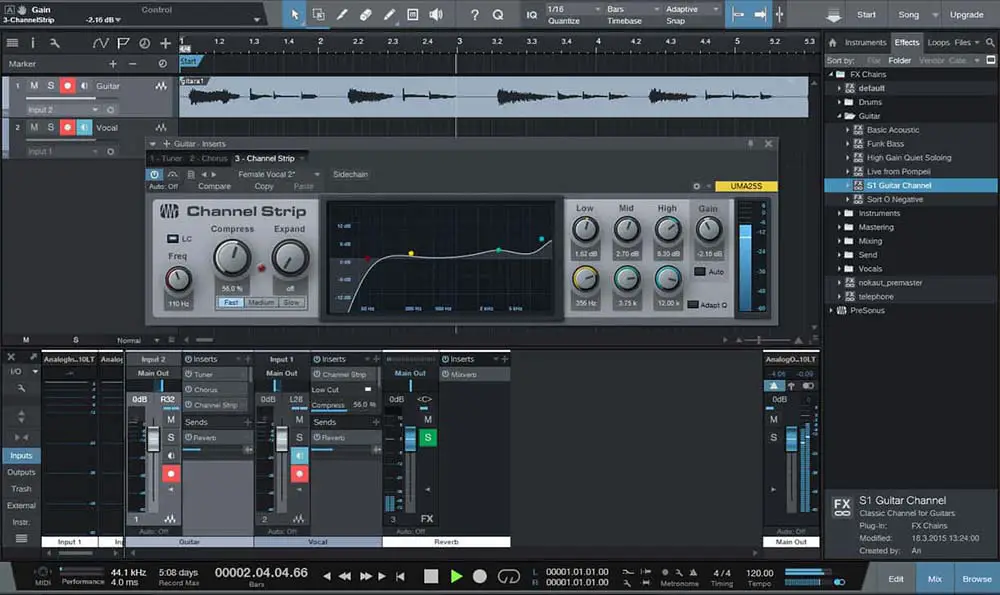
Compatibility: Mac and Windows
Studio One 4 Prime by PreSonus is a well know DAW that is more oriented to those who want to record. However, it’s still a worthy choice for anyone looking to produce beats and its professional FX and processors make it a first choice for anyone looking to produce with either sampled or recorded beats.
Interface: Studio One 4 Prime features a drag-and-drop interface which assembles its various components into one seamless motion. The interface allows you to quickly control the DAW’s 1GB of free samples, 9 software plugins and other controls including a smart browser.
Everything can be dragged, dropped and combined into the homogenous workflow. Studio One 3 Prime also allows for the creation of unlimited audio and MIDI tracks.
Features/Content: In essence, Studio One 4 Prime is a professional DAW. It allows for professional time-stretching, comping and automation of tracks with pro-level algorithms. It also features 9 FX and processors covering a sampler, which allows you to control free bundled loops and samples, reverb, EQ, limiters and compressors. One major drawback, though, is that Studio One 4 Prime doesn’t allow for 3rd party VSTs.
Bottom Line: Pro level DAW with one major drawback: you can’t use 3rd party VSTs or Audio Units (AUs).
5. Pro Tools First
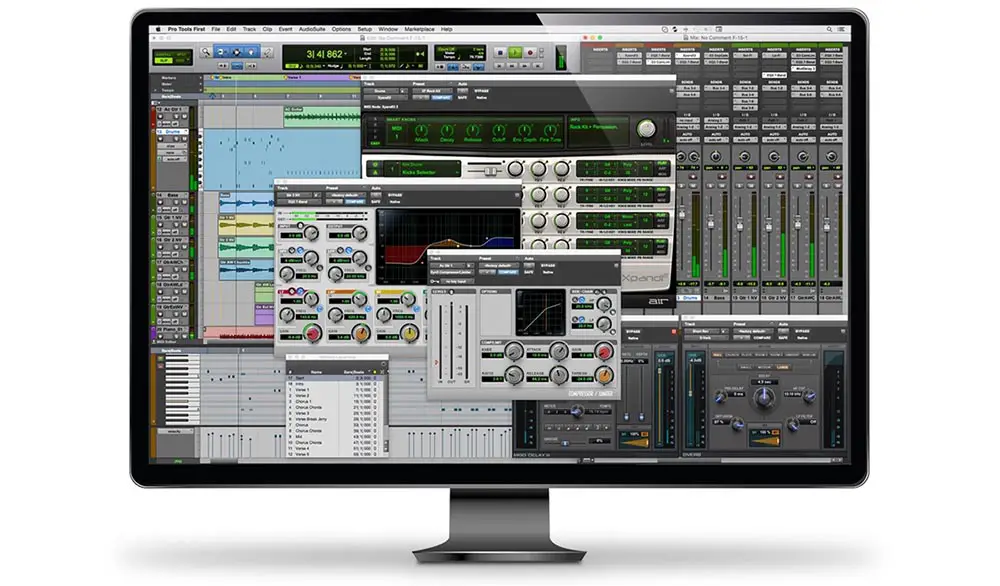
Pro Tools by Avid is an industry-leading DAW that is suitable for any type of music production or beatmaking. Ideal for the composition of beats and samples, recorded music and MIDI productions, Pro Tools First combines many of Pro Tools 12’s features with its unique freemium model.
First and foremost, Pro Tools First allows for the creation of 16 audio or MIDI tracks. It also includes over 20 pro level fx and processors including multiples types of compressors, reverbs, EQs, FX and other funky and creative processors.
The limits, however, prevent you from saving more than 3 projects and these need to be saved to Avid’s cloud. Also, you won’t be able to install or load any AAX plugins which aren’t specifically available on Avid’s marketplace.
Interface: Pro Tools’ interface isn’t the most modern or cutting edge but it’s very easy to use. It’s simple and intuitive, featuring two main views: mix and track view. Track view allows you to edit and control you waveforms; beats and samples, midi tracks and other track audio data like automation. Mix view allows you to adjust sliders, pan and other controls associated to mix levels and input/output.
Content/Features: Pro Tools First cleverly balances its features and limitations. It allows for the composition of advanced music and beats but only 3 at any one time, and with a limit of 16 tracks. For beatmakers, that shouldn’t be of much consequence though. In fact, for basic loop composition and MIDI arrangements, Pro Tools First is virtually all you need. For beatmakers, Pro Tools First also comes with Xpand, which is a great software synth and beat plugin with hundreds or possibly thousands of presets.
Bottom Line: Pro Tools First is powerful and given that you can at least save and option projects, it’s a great choice for beat makers. The limit of 3 projects isn’t ideal but with planning, you can essentially use this first-class software without paying a penny.
6. LMMS
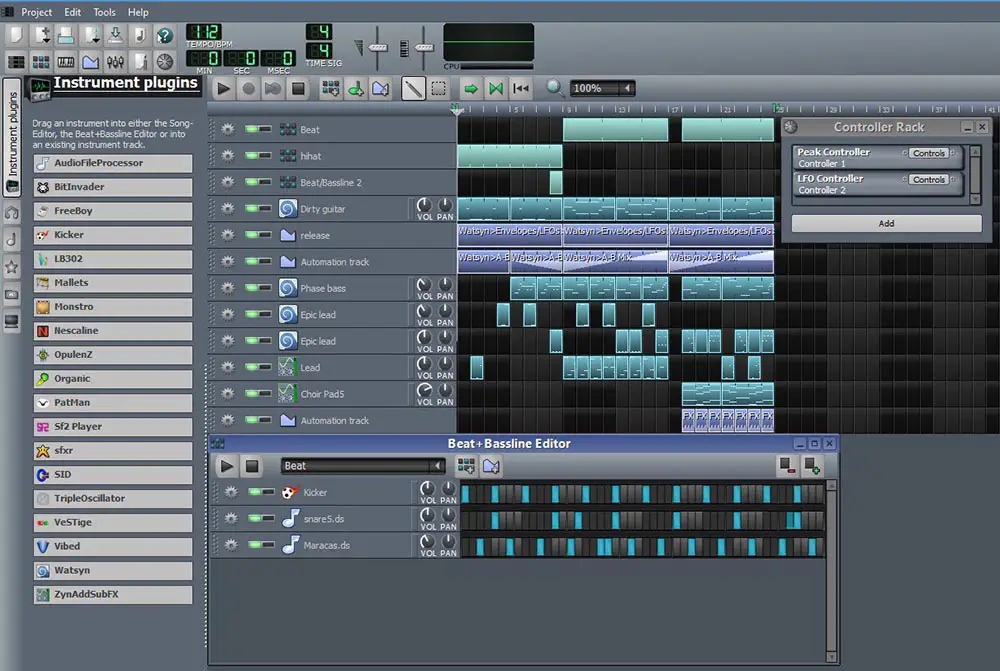
LMMS is an open-source DAW or beat making software inspired by FL Studio. It’s been faithfully created for free by a group of programming volunteers. At the start, this software looked really dated and rather clunky but its come on leaps and bounds and with a slicker interface and tons of pro features, it has to rate very highly as free beatmaking software.
It has actually been built specifically with digital audio design and production in mind – you can’t actually use it to record audio! You could say then, that it’s almost perfectly streamlined for beat makers.
Interface: LMMS is largely based on Image-Line’s FL Studio. That means it has lots of little icons that are easily navigated once you learn them and their uses. The interface is generally more utilitarian than other DAWs – the programmers have put more time into functionality than looks and that’s where this free software shines.
Content/Features: LMMS makes a great stab at recreating a pro DAW for free, with no questions or quibbles about upgrades, limitations, etc. It has everything you need to arrange, edit and process samples and MIDI instruments, which is all you need as a beatmaker. The cornerstones of this fantastic open source software is its free 16 synthesizers.
These include emulations of favourite hardware synths like the Roland TB-303, Commodore 64 and 8 bit sounds from GameBoy and Nintendo devices. It also comes with the ZynAddSubFx synthesizer which is extremely powerful for creating a multitude of pad and lead synth sounds.
Bottom Line: LMMS is brilliant for beatmakers. It isn’t limited at all, is bulletproof in terms of stability and has tons of plugins and tools for creative use right out of the box.
Conclusion
Beat making software comes in many forms. Some DAWs cover everything you’ll need as a DAW and their free trials are often relatively unlimited to those who just want to make beats.
Other softwares are designed to be unlimited by nature. Open source and unimpeded by limitations, they allow for producers to do anything they need to do to get their music from the PC into a file format for playback or further use.
On this list, we’ve overviewed 5 of the best free beat making softwares and honestly, there can be no single winner. They all play to different individual strengths and they’ll appeal to different types of users. One thing is for sure, with any of these programs, perseverance and creativity, you can make professional beats for music and other creative uses.
If, however, you had to narrow it down to one software, LMMS packs in several pro features and lots of free creative tools and the best thing about it is that it’s entirely and absolutely free.
You may also like: